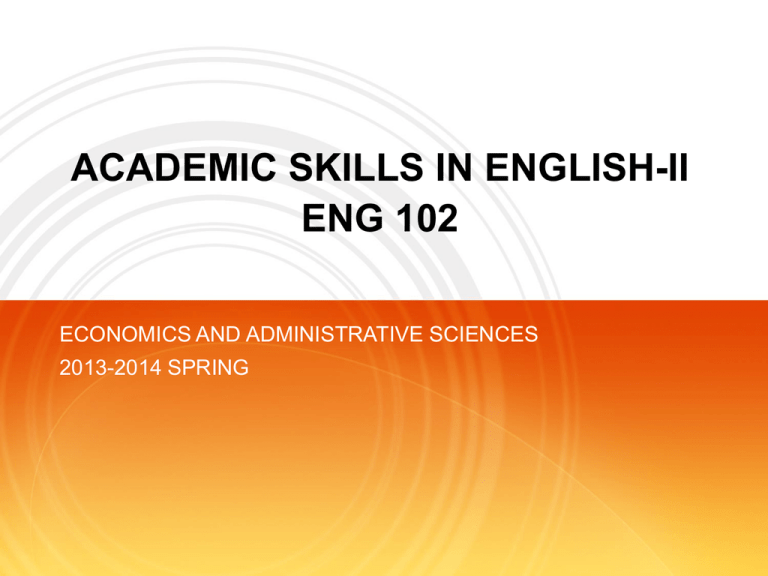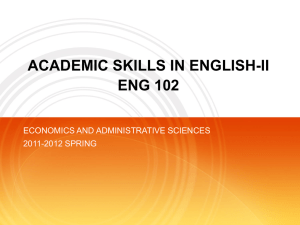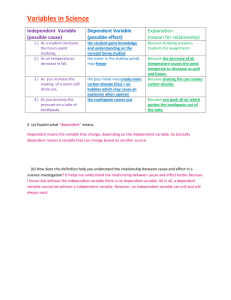ENG 102 Intro. PPT
advertisement

ACADEMIC SKILLS IN ENGLISH-II ENG 102 ECONOMICS AND ADMINISTRATIVE SCIENCES 2013-2014 SPRING Syllabus Your teacher will share the course syllabus with you. Page 2 The Course Aims at the Following: To develop students’ academic reading and writing skills so that they can follow their department courses better. This course will NOT teach students English, instead it will give them opportunities to practice the language and accomplish assigned tasks. Page 3 ENG 102 (SECOND SEMESTER) MODULES ACADEMIC READING ACADEMIC WRITING Page 4 Will help you to become better READERS and WRITERS of English The Reading Module There are 4 Units in the Reading Module Starting from Reading Unit 1, you will be assessed based on your class performance (CPG) You will be using academic reading skills in your department courses as you will be expected to read long academic texts. Page 5 The Reading Module will Train you to: survey a text scan to locate specific information guess the meaning of unknown words understand implicit and explicit information and make inferences understand the text’s purpose extract main points Page 6 Academic Word List (Mini Dictionary) In the reading passages of your book, you will see words in bold. Page 7 Academic Words These words are samples of words that are being widely used in the academic world. You will be asked to learn these words, their synonyms and definitions. Your exams will have a vocabulary component where you will be asked to match these words with their definitions and use them in gap fill activities. You will find these words in the mini dictionary starting at the end of your coursebook. Page 8 Research Skills Unit This is a 4 hour unit which provides you with the basics of research and writing essays. You will be responsible for the content of this unit in all writing units that follow. Page 9 The Writing Module There are 4 Units in the Writing Module At the end of each unit, you will be assessed based on your class performance (CPG) These units will develop your writing skills, by showing ways of doing research, paraphrasing, quoting, summarising and organizing an academic essay. Do not forget that your department teachers may ask you to write long academic essays in different courses on different topics. Page 10 Assessment Midterm (Apr 10, 2014) 25% Quiz (May 12-16, 2014) 10% Writing Project (May 21, 2014) 20% Final Exam (Jun 02-13, 2014) 25% CPG (at the end of every unit) 20% Page 11 Mid-term Exam 25% 2 reading texts ( about 600 words each) 5 different types of reading assessment questions 3 different types of AWL assessment questions Overall Assessment Grading: Reading is worth 80% of the mid-term grade AWL 20% The mid-term exam accounts for 25% of the overall course grade Page 12 Final Exam 25% 2 reading texts (about 600 words each) 5 different types of reading assessment questions 3 different types of AWL assessment questions Overall Assessment Grading: Reading is worth 80% of the final exam grade AWL 20% The final exam accounts for 25% of the overall course grade Page 13 Writing Quiz 10% 12-16 May You will be asked to complete an essay outline in class that includes the following: Essay thesis statement Three topic sentences Two supporting details for each topic sentence Concluding sentence Page 14 The Writing Project 20% 21 May at 18:30 (110 minutes) You will be required to write a full essay of at least 350 words. You will receive three texts one week in advance. The texts will have some guiding questions so if you want to do some research you can do so. The answers to those questions will not be graded. When coming to the exam, you can bring the assigned texts only. You are allowed to take notes on these texts, however you cannot have big chunks of sentences or paragraphs. You can underline/write words or phrases only. Page 15 CPG 20% Class Participation Grade 20% of your course grade Based on tasks done during class and assignments given as homework Your willingness to participate in class work will help you to learn the skills better Your willingness in participating in class work will help you get a higher CPG Page 16 CPG’s Effect on Course Grade Midterm Final Present. CPG Course Grade 62 60 75 90 69.6(CC) 62 60 75 65 64.6(DC) 62 60 75 35 58.6(FD) 62 60 75 0 51.6(FF) – A DIFFERENCE OF FOUR LETTER GRADES! Page 17 Attendance Attendance is obligatory If you miss more than 25% (14 hrs) of total class hours, you will not be allowed to take the final exam. Page 18 Arriving Late to Class Students who are late to the class (more than 15 min) can still attend the class but will be marked as ABSENT by the class teacher. Page 19 Health Reports Health Reports are not counted for absenteeism. They are valid only for Midterm and Final Exams. Page 20 The Reading Questions There are five different types of reading questions in the exams Page 21 Reading Question Type One Example: 1 It is a general tendency for people to believe that motivation is a personal trait. Some people have it and others don’t. In practice, some people are labelled as lazy because they do not display an outward sign of motivation. However, individuals differ in their basic motivational drives. It also depends upon their areas of interest. The concept of motivation is situational and its level varies between different individuals and at different times. If you understand what motivates people, you have available the most powerful tool for dealing with them. Which sentence below is closest in meaning to the highlighted sentence in paragraph 1? a. If you know what motivates someone you have no chance of influencing them. b. To motivate anybody you just have to give them orders, and they will obey c. You can manage people best once you realize what really motivates them Page 22 Reading Question Type Two Example: 1 It is a general tendency for people to believe that motivation is a personal trait. Some people have it and others don’t. In practice, some people are labelled as lazy because they do not display an outward sign of motivation. However, individuals differ in their basic motivational drives. It also depends upon their areas of interest. The concept of motivation is situational and its level varies between different individuals and at different times. If you understand what motivates people, you have available the most powerful tool for dealing with them. Tendency’ means… (paragraph 1) a. a way to improve management methods b. a feeling of really extreme unhappiness c. a general direction in which something tends to move Page 23 Reading Question Type Three Example: 1 It is a general tendency for people to believe that motivation is a personal trait. Some people have it and others don’t. In practice, some people are labelled as lazy because they do not display an outward sign of motivation. However, individuals differ in their basic motivational drives. It also depends upon their areas of interest. The concept of motivation is situational and its level varies between different individuals and at different times. If you understand what motivates people, you have available the most powerful tool for dealing with them. ‘It’ refers to… (paragraph 1) a. motivation b. trait c. people Page 24 Reading Question Type Four Example: 2 A study showed that when the background colour of food packaging was red, people formed more favourable evaluations of products. However, when the background was blue, the opposite pattern of results emerged. It was also found that people were more receptive to a brand of toothpaste that focused on negative messages such as “cavity prevention” when the background colour was red, whereas people were more receptive to inspirational messages such as “tooth whitening” when the background colour was rendered in blue. 1. Which of the following best describes the main topic of paragraph 2? a. why people prefer buying toothpaste that whitens their teeth b. how to effectively combine different colours on a package design c. how background colour can affect the way people view the product Page 25 Reading Question Type Five Example: 2 A study showed that when the background colour of food packaging was red, people formed more favourable evaluations of products. However, when the background was blue, the opposite pattern of results emerged. It was also found that people were more receptive to a brand of toothpaste that focused on negative messages such as “cavity prevention” when the background colour was red, whereas people were more receptive to inspirational messages such as “tooth whitening” when the background colour was rendered in blue. 2. How did people react when the colour red was used on the background of toothpaste packaging? (paragraph 2) a. they believed the toothpaste whitened teeth better b. they looked closer at the negative toothpaste message c. they compared the toothpaste with other products Page 26 The Book You can buy a coursebook from the photocopy shop on -1 Make sure that you get the book for your faculty Depending on the faculty, course books cost between 10 and 15 TL EAP in Economics and Administrative Sciences II Page 27 Any Problems? Attendance Classes Personal Speak to your teacher before it’s too late! Page 28 WE HOPE TO SPEND AN ENJOYABLE, EFFECTIVE AND SUCCESSFUL SECOND SEMESTER WITH YOU. Page 29






